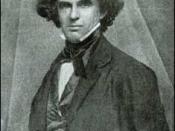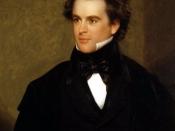American Lit I-2110 September 26, 2001 Mr. Nathaniel Hawthorne wrote "Rappaccini's Daughter"ÃÂ. This famous short story was written around 1844. The story takes place in Italy in a garden that contains natural and scientific flowers. Through out the story there is symbolism.
The story's central symbol is Rappaccini's daughter Beatrice. She functions primarily as a symbol, because Hawthorne does not develop her as a character. Instead he focuses on Giovanni's perceptions of Beatrice. For example, when Giovanni see Beatrice for the first time he describes her as "a young girl, arrayed with as much richness of taste as the most splendid of the flowers, beautiful as the day, and with a bloom so deep and vivid that one shade more would have been to much"ÃÂ (1288-89). Beatrice is seen as an extension of the garden imagery with the intermingling of beauty and decay, health and death, good and evil.
She is lovely but poisonous, innocent yet corrupt. The plant with which she is so intimately associated is the vehicle for evil in the story.
The story focuses on the fountain and how color images support the implications of the garden and flower imagery. The broken fountain represents what Rappaccini has done to his daughter (broken her). The water shows life, which he gave his daughter. The fountain itself is man made which represents Rappaccini using his daughter life as his experiment. Bright sunshine corresponds to the illusions of unspoiled nature and gives the garden the appearance of perfect innocence. The color purple, associated with the flower and Beatrice's dress, is an ambiguous color, often relating to royalty and death and disturbing in its emotional effects.
Finally, there is the color black which is constantly associated with Rappaccini. If sunlight is a positive value and red and purple an...


